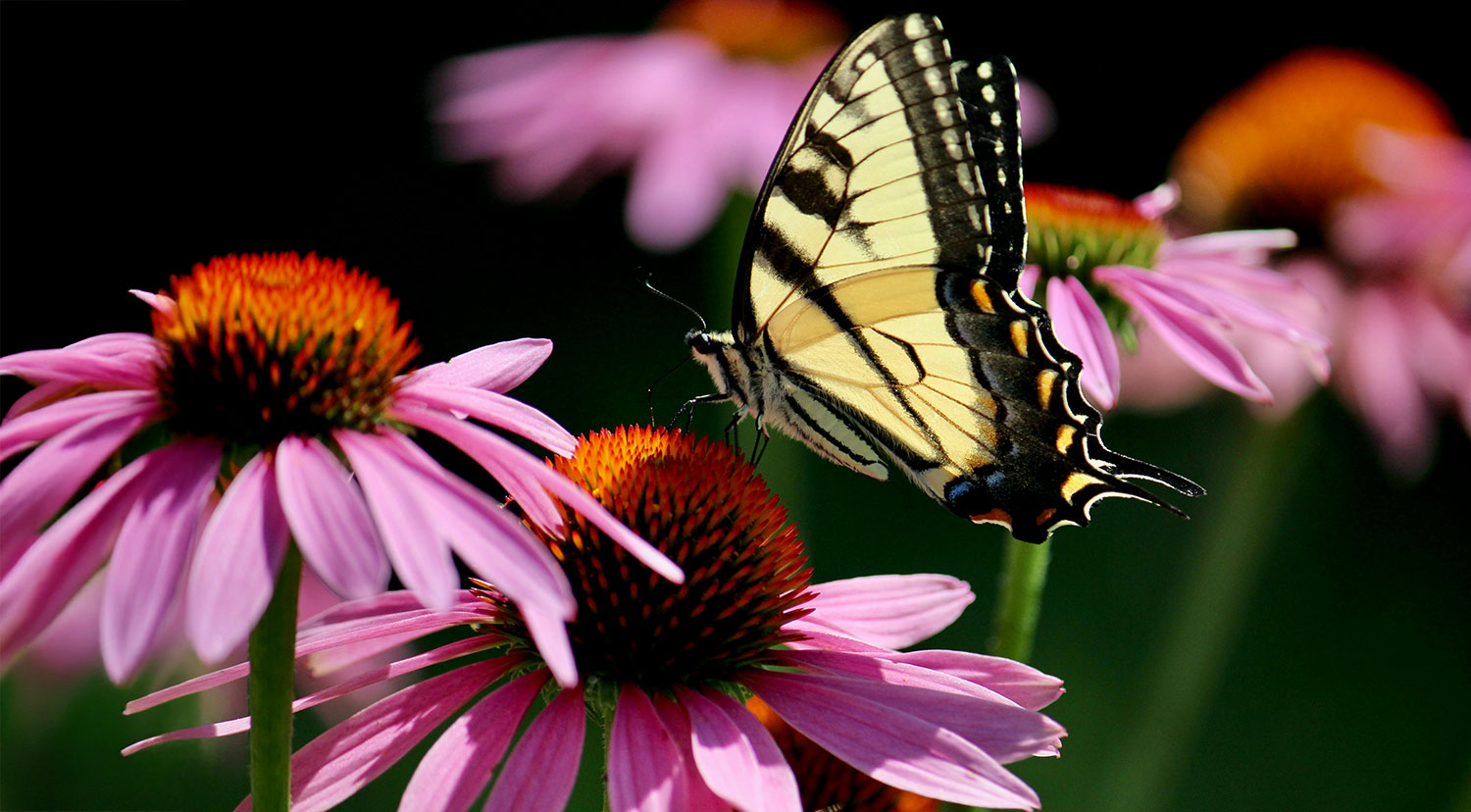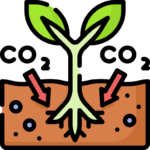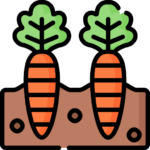
10 Apr April’s Action: Go Native With Native Planting
This season think about going native in your garden. Planting native plants is a powerful nature-based solution to combat climate change and enhance environmental health. By choosing plants that are adapted to the local environment, we can create landscapes that sequester carbon, reduce emissions, support biodiversity, conserve water, and build healthier soils, all of which contribute to a more resilient and sustainable future.
Plant Native and Help the Environment
CARBON SEQUESTRATION
 Storage in Roots and Soil: Many native plants, especially grasses and prairie species, have deep and extensive root systems. These roots store a significant amount of carbon pulled from the atmosphere during photosynthesis. As the roots die and decompose, the carbon is incorporated into the soil, where it can remain for long periods.
Storage in Roots and Soil: Many native plants, especially grasses and prairie species, have deep and extensive root systems. These roots store a significant amount of carbon pulled from the atmosphere during photosynthesis. As the roots die and decompose, the carbon is incorporated into the soil, where it can remain for long periods.
Superior to Lawns: Studies show that native prairie ecosystems can sequester significantly more carbon in the soil compared to traditional turfgrass lawns due to their deeper root systems and greater biomass.
Long-Term Storage: Unlike the carbon stored in the above-ground biomass of trees which can be released during wildfires, carbon stored in the deep roots of native plants is better protected from such events.
REDUCED CARBON EMISSIONS
 Less Maintenance: Native plants are adapted to the local climate and soil conditions, requiring less watering, fertilizers, and pesticides once established. The production and transportation of these inputs contribute to greenhouse gas emissions.
Less Maintenance: Native plants are adapted to the local climate and soil conditions, requiring less watering, fertilizers, and pesticides once established. The production and transportation of these inputs contribute to greenhouse gas emissions.
No or Less Mowing: Native plant landscapes often require little to no mowing, eliminating the carbon emissions associated with lawnmowers and other power equipment.
ENHANCED BIODIVERSITY: SUPPORT BIODIVERSITY AND ECOSYSTEM HEALTH
 Support for Local Wildlife: Native plants have co-evolved with local wildlife, providing essential food (nectar, pollen, seeds, fruits) and shelter for native insects, pollinators, birds, and other animals. This intricate web of life supports a healthy and resilient ecosystem.
Support for Local Wildlife: Native plants have co-evolved with local wildlife, providing essential food (nectar, pollen, seeds, fruits) and shelter for native insects, pollinators, birds, and other animals. This intricate web of life supports a healthy and resilient ecosystem.
Foundation of the Food Web: Native plants form the base of the food web, and their presence in abundance is crucial for sustaining the diversity of animal life. For example, native trees can support hundreds of caterpillar species, which are a primary food source for many birds.
Climate Resilience: Diverse ecosystems with a strong native plant component are generally more resilient to the impacts of climate change, such as extreme weather events and the spread of invasive species.
IMPROVED WATER MANAGEMENT: REDUCE EROSION
 Drought Resistance: Native plants are adapted to local rainfall patterns and are often more drought-tolerant than non-native species, reducing the need for supplemental watering as climate change leads to more frequent and intense droughts.
Drought Resistance: Native plants are adapted to local rainfall patterns and are often more drought-tolerant than non-native species, reducing the need for supplemental watering as climate change leads to more frequent and intense droughts.
Water Infiltration and Reduced Runoff: The deep root systems of many native plants help increase the soil’s capacity to absorb and retain water, reducing surface runoff and the associated erosion and pollution of waterways. This can also help mitigate flooding.
HEALTHIER SOILS
 Enhanced Soil Structure: The leaves and stems of native plants decompose, adding organic matter to the soil and improving its structure and nutrient content.
Enhanced Soil Structure: The leaves and stems of native plants decompose, adding organic matter to the soil and improving its structure and nutrient content.
Improved Soil Structure: Native plant root systems enhance soil structure, increasing aeration and water-holding capacity.
Nutrient Cycling: Native plants contribute to healthy nutrient cycling in the soil, reducing the need for artificial fertilizers.
Symbiotic Relationships: Many native plants form beneficial relationships with soil microorganisms, further enhancing soil health and carbon sequestration.
A Guide to Planting Native in Maine
This step-by-step guide is designed to help you successfully introduce more native plants into your garden and landscape, creating a beautiful, sustainable, and ecologically beneficial space.
PLANNING AND PREPARATION
1. Assess Your Site: Observe your garden and landscape throughout the day to understand the different light conditions (sun, shade, part-shade), soil types (sandy, clay, loamy), and moisture levels (dry, moist, wet). Native plants thrive when planted in conditions that mimic their natural habitat.
2. Identify Existing Plants: Determine which plants in your yard are already native and which are not. This will help you understand what you have and where you can introduce new natives. Resources like the Maine Audubon Native Plant Finder and Lady Byrd Johnson Wildflower Center can be helpful for identification.
3. Define Your Goals: What do you hope to achieve by adding native plants? Are you looking to attract more pollinators, create a low-maintenance area, improve soil health, or simply enhance the natural beauty of your landscape?
4. Remove Invasive Non-Native Plants: Identify and remove any invasive species like Japanese barberry, purple loosestrife, or Oriental bittersweet. The Maine Department of Agriculture, Conservation and Forestry provides lists and information on invasive plants in Maine.
5. Plan Your Design: Consider the mature size and shape of the native plants you choose and how they will fit into your existing landscape. Think about creating layers of vegetation (groundcovers, shrubs, trees) to mimic natural plant communities.
SELECTING NATIVE PLANTS
Choose Locally Native Species: Opt for plants that are native to Maine and ideally to the Freeport area or similar regions within the state. These plants will be best adapted to the local climate, soil, and wildlife. Helpful resources include Maine Audubon Native Plant Finder, Coastal Maine Botanical Gardens video garden highlights Tough Natives for the Northeast, the University of Maine Cooperative Extension Gardening to Conserve Maine’s Native Landscape Plants to Use and Plants to Avoid and USDA Native Gardening.
Consider Plant Communities: Research which native plants naturally grow together in Maine. Planting in communities can create a more resilient and ecologically functional landscape.
Select for Different Seasons: Choose a variety of plants that offer interest throughout the year, including spring flowers, summer foliage, fall colors, and winter berries or structure. This will support wildlife year-round.
Think About Wildlife Value: Select plants known to attract pollinators (bees, butterflies, moths, hummingbirds), provide food for birds (berries, seeds), and offer habitat for other beneficial insects and wildlife. For example, milkweed is crucial for monarch butterflies, and oak trees support hundreds of caterpillar species.
Consider Your Site Conditions: Match your plant selections to the specific light, soil, and moisture conditions of each planting area in your garden.
SOURCING NATIVE PLANTS
Reputable Native Plant Nurseries: Purchase your plants from nurseries that specialize in locally sourced, nursery-propagated native plants. Avoid plants collected from the wild, as this can harm native populations. Several nurseries in Maine focus on native species. You can find lists of these resources through organizations like Wild Ones Midcoast Maine
Local Organizations: Check with local garden centers and organizations like Maine Audubon, soil and water conservation districts, and native plant societies such as The Garden Club Federation of Maine, as they often have plant sales or recommendations for where to buy native plants.
Seed Saving (with caution): If you are knowledgeable about plant identification and ethical collection, you can collect seeds from native plants in your area with permission. The Wild Seed Project offers resources and seeds and Prairie Moon Nursery has an extensive selection of native seeds and plants.
PLANTING NATIVE PLANTS
Prepare the Soil: While native plants are adapted to local soils, you may need to amend the soil in specific areas. Generally, avoid adding excessive fertilizers or compost, as native plants often thrive in less rich soils. Ensure good drainage.
Plant at the Right Time: Fall or early spring are generally the best times to plant in Maine, as this allows the plants to establish roots before the heat of summer or the cold of winter.
Follow Planting Instructions: Plant your new natives at the recommended depth and spacing. Water them thoroughly after planting.
Mulch Appropriately: Use a natural mulch, such as leaf litter or pine needles, to help retain moisture, suppress weeds, and mimic natural conditions. Avoid using dyed wood mulch.
EDUCATE YOURSELF AND OTHERS
Learn Continuously: There are many excellent resources available to help you learn more about native plants in Maine. Explore websites, books, and local workshops offered by organizations like Maine Audubon and the Coastal Maine Botanical Gardens.
Share Your Knowledge: Talk to your neighbors and friends about the benefits of native plants and encourage them to incorporate them into their landscapes.
Remember that establishing a native plant garden is an ongoing process, and with patience and observation, you will see it flourish and support local wildlife.



